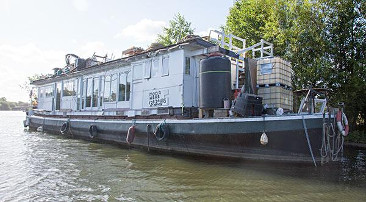Court confirms no long-term Thames mooring
THERE has been a landmark judgment at Kingston County Court confirming that the navigation licence fee payable by boat owners relates only to the right to pass along the Thames, and gives no right to long term or permanent mooring.
Two cases of trespass were brought by the Environment Agency (EA) against Alastair Trotman, owner of the so-called Slumboat, until recently moored by Molesey Lock, and three other boats illegally moored upstream of Teddington Lock, Roger Fox tells us.
 Move the vessels immediately
Move the vessels immediately
In both cases the court granted possession orders to the Agency as owner of the sites, that means that Alastair Trotman is obliged to move the vessels immediately.
The Slumboat is a wide beam barge with no engine, and for reasons of safety, the ruling was given that the boat be escorted by people from the EA due to the complexities of tides and currents. The other three are 'supply vessels'.
Pulled boat downstream
The original summons for the Slumboat related to trespass on land alongside houses in Hampton Court Crescent, and after being issued with the summons Alastair Trotman pulled the boat downstream by ropes through a lock to a new position.
Last weekend he also pulled his supply vessels through the lock. At the hearing the EA pointed out that this was a move of only some 100 metres and the judge allowed the reference on the possession notice to be altered to the present location.
Defence dismissed
Alastair Trotman's main defence was that the EA is not a freeholder and therefore cannot bring a case of trespass and argued that public bodies do not have access to common law and only have the statutory powers they are given by the state. This however was dismissed by the judge who said that Land Registry documents showed the EA to have title absolute over the lands in question with the same rights of protection from trespass as any other landowner.
The judge also dismissed his argument that the navigation licence conferred a long-term right to moor.
The Slumboat
The Slumboat was built on an old Thames coal barge and converted into rooms that were let out. (Fire hazard boat renting rooms) It was moored in various places along the Thames, often a hazard to navigation and often to the annoyance of people living nearby who objected to its run-down state and the activity of its many residents.
It comprised of ten 'cabins' and was generally known as a 'doss house'.
